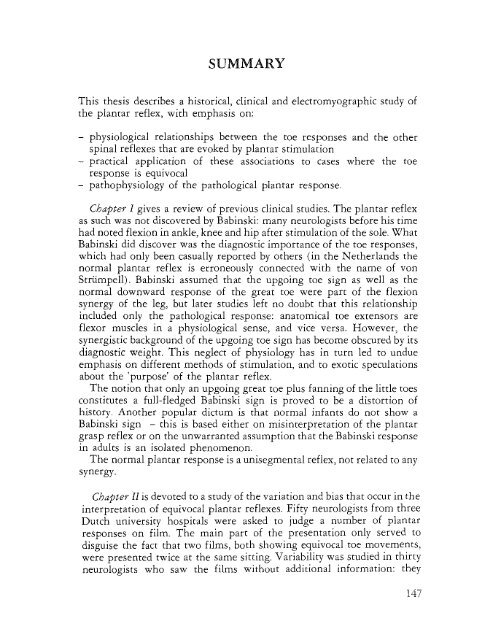You also want an ePaper? Increase the reach of your titles
YUMPU automatically turns print PDFs into web optimized ePapers that Google loves.
SUMMARY<br />
This thesis describes a historical, clinical and electromyographic study of<br />
the plantar reflex, with emphasis on:<br />
- physiological relationships between the toe responses and the other<br />
spinal reflexes that are evoked by plantar stimulation<br />
- practical application of these associations to cases where the toe<br />
response is equivocal<br />
- pathophysiology of the pathological plantar response.<br />
Chapter I gives a review of previous clinical studies. The plantar reflex<br />
as such was not discovered by Babinski: many neurologists before his time<br />
had noted flexion in ankle, knee and hip after stimulation of the sole. What<br />
Babinski did discover was the diagnostic importance of the toe responses,<br />
which had only been casually reported by others (in the Netherlands the<br />
normal plantar reflex is erroneously connected with the name of von<br />
Striimpell). Babinski assumed that the upgoing toe sign as well as the<br />
normal downward response of the great toe were part of the flexion<br />
synergy of the leg, but later studies left no doubt that this relationship<br />
included only the pathological response: anatomical toe extensors are<br />
flexor muscles in a physiological sense, and vice versa. However, the<br />
synergistic background of the upgoing toe sign has become obscured by its<br />
diagnostic weight. This neglect of physiology has in turn led to undue<br />
emphasis on different methods of stimulation, and to exotic speculations<br />
about the 'purpose' of the plantar reflex.<br />
The notion that only an upgoing great toe plus fanning of the little toes<br />
constitutes a full-fledged Babinski sign is proved to be a distortion of<br />
history. Another popular dictum is that normal infants do not show a<br />
Babinski sign - this is based either on misinterpretation of the plantar<br />
grasp reflex or on the unwarranted assumption that the Babinski response<br />
in adults is an isolated phenomenon.<br />
The normal plantar response is a unisegmental reflex, not related to any<br />
synergy.<br />
Chapter II is devoted to a study of the variation and bias that occur in the<br />
interpretation of equivocal plantar reflexes. Fifty neurologists from three<br />
Dutch university hospitals were asked to judge a number of plantar<br />
responses on film. The main part of the presentation only served to<br />
disguise the fact that two films, both showing equivocal toe movements,<br />
were presented twice at the same sitting. Variability was studied in thirty<br />
neurologists who saw the films without additional information: they<br />
147
















